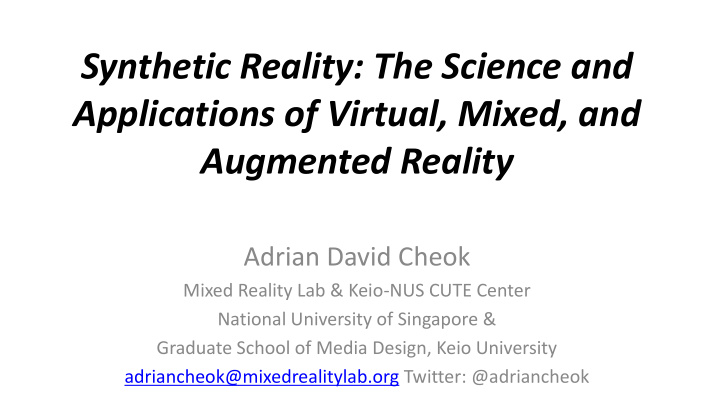



Synthetic Reality: The Science and Applications of Virtual, Mixed, and Augmented Reality Adrian David Cheok Mixed Reality Lab & Keio-NUS CUTE Center National University of Singapore & Graduate School of Media Design, Keio University adriancheok@mixedrealitylab.org Twitter: @adriancheok
Network Society Greek society Each individual connected all the time through networks Modern society Ryohei Nakatsu
Pessimist vs. Optimist Individual identity and self consciousness will degrade We will lose creativity and individuality Wired self consciousness will become social consciousness New relationship between individuals and society
Wim Veen: “Homo Zappiens, Growing up in a digital age” Next generation, first to grow up in digital era Learning is playing School no longer primary importance, a meeting place
Iconic Skills http://ballouonvisualcomms.files.wordpress.com/2009/10/pict ure-93.png?w=451&h=504 http://azk12.org/downloads/blogimages/Audacity-PPT- MM_icons.jpg http://www.depauw.edu/sfs/images/Wong1.jpg
Processing discontinued information Channel 1 Channel 2 Channel 3 Wim Veen: Constructing interrupted visual, audio and textual information chunks into meaningful knowledge
Non-linear, Collaborative, Active http://www.kerismith.com/WishJarTales/nonlinear1lg.jpg
Education Digital Kids own activities of zapping, multitasking, scanning, prepares for their own future Schools are underestimating the Digital Kids Use resources from anywhere, and forget linear text books Schools should move from teacher led to learner led
• Impact of television on public discourse Effect of image based culture on critical thinking • • Age of Exposition (New York) to the Age of Show Business (Las Vegas)
Graphic: Stuart McMillen
The Age of Entertainment “Our politics, religion, news, athletics, education, and commerce have been transformed into congenial adjuncts of show business, largely without protest or even much popular notice. The result is that we are a people on the verge of amusing ourselves to death”.
The End of Solitude - William Deresiewicz Convergence of Visual culture of entertainment/celebrity, and computer culture of connectivity Celebrity and connectivity are both ways of becoming known. This is what the contemporary self wants.
Current brain science and psychological model is that of the networked or social mind. The End of Solitude
Research Research: Merging real world with virtual world with all of our senses From “Information Communication” to “Experience Communication”
BACKGROUND Kitchen Media Family relationships are undergoing a rapid evolution due to the busy life styles of people. Less physical interaction between family members have made our lives more isolated. The kitchen is a significant place for the family members to interact with In general, the time spent with our family is more centrally located around the kitchen space.
CO-COOKING & CO-DINING COMMUNICATION Co Share
CO-COOKING SYSTEM
LID & INTERFACE
FOOD PRINTING DEVICES
RICE COOKER PRINTER
RICE & FOOD PRINTER
CO-DINING DEVICES
AmbiKraf Non-Immersive Color Changing Fabric
Smell and Taste Experience • Emotions • Personal memories • Daily experience • Cultural influence
Current Smell and Taste Communication Technologies & Applications • Chemical based • Analog • Impractical to transmit • Scalability • Digital controllability Visual component Equivalent component in smell and taste?
Remote Taste and Smell Communications • Digital control • Transmit over network • Create new communication possibilities
Phase I - Electrical / Thermal Stimulation • Sensing • Actuation • Bi-directional communication • Possible enhancements
Initial Experiment • Experiment based on previous studies to trigger primary taste • Determine characteristic of current/frequency/voltage vs. perception of taste References: Plattig K. H. and Innitzer J., Taste qualities elicited by electric stimulation of single human tongue papillae, European Journal of Physiology, 361(2):115-120, 1976
Future Work – Brain Stimulation Identification – Identify Stimulation - Stimulate identified Perception - Create perception of corresponding areas (nucleus) in nucleus by magnetic stimulation to tasting real food or smelling real the brain by observing fMRI data regenerate the brain activities scent induced by natural food and chemical compounds
Asian Culture vs. Western Culture
Role of Asia in Network Society: Take initiative in R&D in 21st century.
Recommend
More recommend